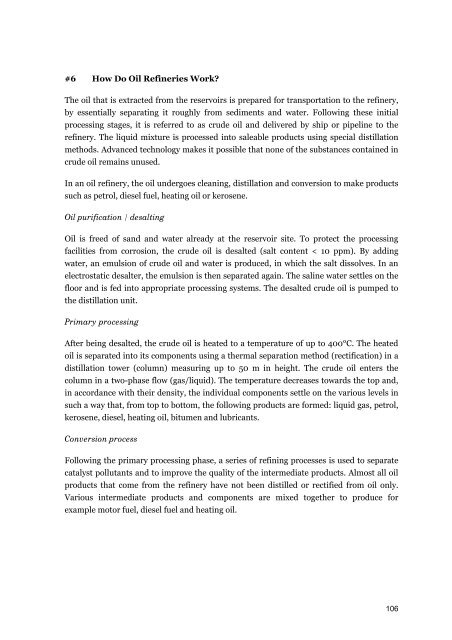PEAK OIL
PEAK OIL
PEAK OIL
Create successful ePaper yourself
Turn your PDF publications into a flip-book with our unique Google optimized e-Paper software.
#6 How Do Oil Refineries Work?<br />
The oil that is extracted from the reservoirs is prepared for transportation to the refinery,<br />
by essentially separating it roughly from sediments and water. Following these initial<br />
processing stages, it is referred to as crude oil and delivered by ship or pipeline to the<br />
refinery. The liquid mixture is processed into saleable products using special distillation<br />
methods. Advanced technology makes it possible that none of the substances contained in<br />
crude oil remains unused.<br />
In an oil refinery, the oil undergoes cleaning, distillation and conversion to make products<br />
such as petrol, diesel fuel, heating oil or kerosene.<br />
Oil purification / desalting<br />
Oil is freed of sand and water already at the reservoir site. To protect the processing<br />
facilities from corrosion, the crude oil is desalted (salt content < 10 ppm). By adding<br />
water, an emulsion of crude oil and water is produced, in which the salt dissolves. In an<br />
electrostatic desalter, the emulsion is then separated again. The saline water settles on the<br />
floor and is fed into appropriate processing systems. The desalted crude oil is pumped to<br />
the distillation unit.<br />
Primary processing<br />
After being desalted, the crude oil is heated to a temperature of up to 400°C. The heated<br />
oil is separated into its components using a thermal separation method (rectification) in a<br />
distillation tower (column) measuring up to 50 m in height. The crude oil enters the<br />
column in a two-phase flow (gas/liquid). The temperature decreases towards the top and,<br />
in accordance with their density, the individual components settle on the various levels in<br />
such a way that, from top to bottom, the following products are formed: liquid gas, petrol,<br />
kerosene, diesel, heating oil, bitumen and lubricants.<br />
Conversion process<br />
Following the primary processing phase, a series of refining processes is used to separate<br />
catalyst pollutants and to improve the quality of the intermediate products. Almost all oil<br />
products that come from the refinery have not been distilled or rectified from oil only.<br />
Various intermediate products and components are mixed together to produce for<br />
example motor fuel, diesel fuel and heating oil.<br />
106


